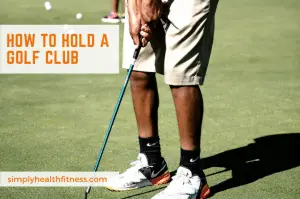
When learning the game of golf, it’s important to remember that your only connection point to the club is your hands. Golfers find the grip to be annoying to practice. It’s certainly not as fun as ripping a 250-yard drive. However, learning and mastering the grip is essential.
In this guide, we will give you step by step instructions for learning how to hold a golf club correctly. You will be able to take these steps and immediately apply them to your golf game.
How To Properly Hold A Golf Club
To make this a bit easier to read, we will always refer to the right-handed golfer. If you happen to be a left-handed golfer, just flip the directions to get steps tailored to your needs.
Step One
Take the golf club and rest it on your leg. Then you will want to take your left hand and lay the top of the golf club grip across the fingers of this hand. Once your fingers are in place, you can repeat this step with your right hand. As you will notice, the thumb from your left hand will fit in the palm of your right hand.
Step Two
If you now look at the index finger of your left hand and the pinky of your right hand, you will see that they are resting side by side. You have three options when it comes to how to position these fingers.
- Ten Finger Grip: Leave the fingers just as they are with all ten fingers on the club.
- Overlap Grip: Take the pinky of your right hand and rest it on the top of your index finger of the left hand.
- Interlock Grip: Take your index finger on your left and the pinky on your right and interlock them.
All three grips have their positives and negatives. As a beginner, it is usually most comfortable to start with the ten-finger grip or the interlocking grip. These two grips tend to give you the most stability and comfort as a new player.
Step Three
Now that you have both hands on the club, we must talk about the position of the hands in relation to the clubface. Depending on how your hands are rotated, you may be setting up either square (neutral), strong or weak.
- If your hands are neutral on the club then the V made by your thumb and forefinger of your right hand will be pointing to your right shoulder. This is the ideal position to have your hands.
- If your hands are in a strong position, your right hand will be much more under the golf club. This grip position will give your right hand a bit more power when coming through the golf ball, and it can help to fix a slice.
- A weak grip is when your right hand comes over the top of the grip and that V that we talked about with the neutral grip is almost not even visible. If you hook the golf ball, a weak grip can help.
Now that you have a general idea of how to place your hands on the golf club, there are a few other factors that we must discuss. The first is grip pressure.
Grip Pressure
As a beginner learning how to hold a golf club can be overwhelming. The entire game is overwhelming. The problem is that many people take the stress of being a new golfer out on the club. Gripping a golf club to death is going to have very negative impacts on your golf game.
When you hold a golf club in your hand, you want to make sure that you have enough pressure not to throw the club, but not so much pressure that you restrict the club from doing what it needs to do. This can be a delicate balance to master, and it will not come your first week out on the course.
If you start having a bad round, check the tension in your grip. It can lead to many swing flaws.
Grip Type
When you are learning how to grip a golf club, you may not even realize the different grip types available. There is a wide range of grips that you can purchase to help you get the right feel on the golf club.
Some grips have a bit more tack to them to help you maintain control. Other grips will be softer and have more cushion for those that may find their golf grips are tearing at their hands.
There is no perfect grip type, but understanding that you have options is critical.
Hand Size
How you grip a golf club can sometimes be related to how large your hands are. A golfer with small hands tends to enjoy the interlocking grip while those with large hands prefer the overlap.
If your hands are large, you may also look into a midsize golf grip. These grips are thicker than a traditional golf grip, and they will feel more comfortable for a golfer with large hands. If you wear an extra-large size golf glove, you may want to look into a more substantial grip.
How To Practice Your Golf Grip
Learning to hold a golf club properly is going to take some time. Unfortunately, when you first start the game, the grip is going to feel a bit foreign to you. Over time things will get more comfortable and feel more natural. Here are a few tips for practicing your golf grip.
- You don’t need to be on the golf course to practice your golf grip. You can grip a pencil while you are waiting for your meeting to start. Try to get your hands on a golf club just a few times a day, and it will do wonders for muscle memory.
- If you think you need extra help with your grip, there are golf trainer grips that you can purchase. Put the trainer on an old club that you use for swinging in the back yard. This will allow you ample opportunity to practice and get the proper feel.
- When you go to the driving range, make sure you are checking your grip before each shot. You will not need to do this for long, but in the beginning, it makes sense. Standing there and hitting shot after shot without being intentional about the grip will not help you long term.
Conclusion
Hopefully, our guide on how to hold a golf club gave you the information you need to feel comfortable with a club in your hands. Don’t put too much pressure on yourself to master the grip immediately. Take your time, be intentional about your practice, and make sure your fundamentals are perfect. Learning the grip properly from the start will make your entire golf career that much more successful.



